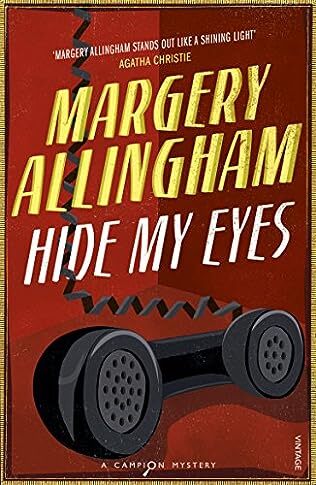Hide My Eyes

A review of Hide My Eyes by Margery Allingham – 230823
Originally published in 1958 and the sixteenth in Allingham’s Abert Campion series, Hide My Eyes, which also goes by the alternative title of Tether’s End, is quite unlike any other of her books that I have read. It is barely a detective story, more a thriller with a bit of an inverted murder story thrown in, Campion is only a peripheral character, and there is little of the eccentricity and humour that feature in her other works. It is an altogether darker book, one in which Allingham explores the manifestation of evil that is embodied in one of her more believable and finely drawn characters, Jeremy Hawker.
By any standard Hawker is a nasty piece of work, and as we follow him around for a day, we see that his every action is calculated not only to bring him an advantage but also to protect him in a cocoon of plausible alibis. He uses people to his advantage, but he is not a top rank criminal with his eye on the main prize. His crimes are grubby, generating enough to keep the wolf from the door for a few months, preying on the weaknesses of others and committed with unconscionable violence. There is nothing to like about him and Allingham goes to great lengths to ensure that her reader despises him. It is a masterpiece of characterisation.
The counterpoint to the evil Hawker is Polly Tassie, an old woman who runs a museum of curiosities in honour of her dead husband, Freddie. Hawker is the nearest thing to a son to her and she loves him with the devotion of a mother. She has been blind to his imperfections, always willing to put a kind and positive spin to his actions and to the way he treats her and others. Hawker’s relationship with Polly is the nearest Allingham allows him to have any kind of human emotion and event then he uses her for his own ends. It is unconditional love pitted against extreme callousness.
One of the book’s fascinations is how the scales slowly fall from Polly’s eyes and, at first, unwillingly and then inevitably she sees him for what he really is. In a moving scene towards the end of the book, she begs him to see the errors of his ways, to save his soul, but her entreaties fail to sway him and there is some satisfaction for the reader that Allingham makes her the architect of his downfall.
This compelling psychological study, a Manichaean struggle between good and evil, is wrapped around a series of seemingly unrelated incidents which have occurred around a relatively small patch of London, Garden Green, including the Goss Place murder involving a coach with an elderly couple on board. Only Charlie Luke, now based at Scotland Yard, thinks that there are links between the incidents, even going to the extent of having a telephone hot line installed at the cost of thirty shillings.
Of course, his instincts are correct and slowly, with the assistance of a shadowy Campion, he gets on to the trail of Hawker. Also involved in the tale are Polly’s niece, Annabelle, and her beau, Richard Waterfield. Waterfield is intrigued when he sees Hawker enter the same building as Annette and spends the day trailing him around, in part becoming enmeshed in one of Hawker’s attempts to create an alibi and in part increasingly convinced that there is something so suspicious about Hawker that he needs to carry out his own investigations. He has an important part to play in the exciting denouement.
I have sometimes wondered why Allingham is so highly regarded as a writer, but this book has convinced me she is one of the crime classic greats.



